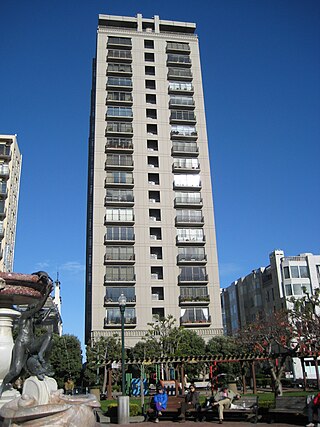
Eviction is the removal of a tenant from rental property by the landlord. In some jurisdictions it may also involve the removal of persons from premises that were foreclosed by a mortgagee.

A lease is a contractual arrangement calling for the user to pay the owner for the use of an asset. Property, buildings and vehicles are common assets that are leased. Industrial or business equipment are also leased. Basically a lease agreement is a contract between two parties: the lessor and the lessee. The lessor is the legal owner of the asset, while the lessee obtains the right to use the asset in return for regular rental payments. The lessee also agrees to abide by various conditions regarding their use of the property or equipment. For example, a person leasing a car may agree to the condition that the car will only be used for personal use.
A leasehold estate is an ownership of a temporary right to hold land or property in which a lessee or a tenant has rights of real property by some form of title from a lessor or landlord. Although a tenant does hold rights to real property, a leasehold estate is typically considered personal property.
Replevin or claim and delivery is a legal remedy which enables a person to recover personal property taken wrongfully or unlawfully, and to obtain compensation for resulting losses.
A rental agreement is a contract of rental, usually written, between the owner of a property and a renter who desires to have temporary possession of the property; it is distinguished from a lease, which is more typically for a fixed term. As a minimum, the agreement identifies the parties, the property, the term of the rental, and the amount of rent for the term. The owner of the property may be referred to as the lessor and the renter as the lessee.
Habitability is the adequacy of an environment for human living. Where housing is concerned, there are generally local ordinances which define habitability. If a residence complies with those laws, it is said to be habitable. In extreme environments, such as space exploration, habitability must take into account psychological and social stressors, due to the harsh nature of the environment.
Landlord harassment is the willing creation, by a landlord or their agents, of conditions that are uncomfortable for one or more tenants in order to induce willing abandonment of a rental contract. This is illegal in many jurisdictions, either under general harassment laws or specific protections, as well as under the terms of rental contracts or tenancy agreements.

Masabumi Kikuchi was a Japanese jazz pianist and composer known for his unique playing style. He worked with many diverse musicians, including Sonny Rollins, Miles Davis, McCoy Tyner, Elvin Jones, Gary Peacock and Paul Motian, and collaborated with Gil Evans and Tōru Takemitsu.
A security deposit is a sum of money held in trust.

Landlord–tenant law is the field of law that deals with the rights and duties of landlords and tenants.
Case v. Minot, 158 Mass. 577 (1893), was a case decided by the Supreme Court of Massachusetts that was one of the first cases to hold that inaction by a landlord could establish a constructive eviction.
In property law, the American rule of possession states that a landlord is obligated only to deliver legal possession, but not actual possession, of a leased premises to a tenant. Thus, if a tenant arrives at a leased premises only to discover that it is still inhabited by a previous tenant who is holding over, or by squatters, it is the tenant who has standing to sue for eviction and/or damages, and not the landlord. The tenant may not cancel the lease or refuse to pay rent due to the landlord for the time that the tenant is out of actual possession of the lease. The American rule survives in only a minority of jurisdictions.
A Section 8 notice, also known as the Section 8 notice to quit or Form 3. It is a prerequisite if the landlord of an assured tenancy or assured shorthold tenancy wishes to obtain possession order from the court, thereby ending the tenancy, for a reason based on a circumstance entitling the landlord to possession under the grounds pleaded. It is used in England and Wales and is part of the Housing Act 1988. as amended by the Housing Act 1996.
In commercial real estate leases in the United States, the landlord, rather than the tenant, is usually responsible for real estate taxes, maintenance, and insurance. In a "net lease", in addition to base rent, the tenant or lessee is responsible for paying some or all of the recoverable expenses related to real-estate ownership. As the rent collected under a net lease is "net" after expenses are passed through to tenants to be paid, the rent tends to be lower than rent charged under a "gross lease".
In United States real estate, a bond lease, also called an absolute triple net lease, true triple net lease or even a hell-or-high-water lease is the most extreme form of the NNN lease, in which the tenant is responsible for every fathomable real estate risk related to the property and is responsible for every single property related expense, even in instances of a material casualty/condemnation.
The Landlord and Tenant Board was an adjudicative tribunal operating in the province of Ontario that provides dispute resolution of landlord and tenant matters under the Residential Tenancies Act, 2006. It is one of the 13 adjudicative tribunals overseen by the Ministry of the Attorney General that make up Tribunals Ontario.
A sitting tenant is a tenant already in occupation of premises, especially when there is a change of owner. Sitting tenants can result from a decision not to evict an assured shorthold tenant following a change of owner or where there is a protected tenancy. Where a landlord sells a property but decides not to evict a tenant the new landlord is said to 'step in the shoes' of the old landlord and the terms of the tenancy continue.
Rent regulation in England and Wales is the part of English land law that creates rights and obligations for tenants and landlords. The main areas of regulation concern,

Arizona Tenants Advocates (ATA) is a non-profit renters' union and tenants' rights organization located in Tempe, Arizona. It was founded in 2001 by Kenneth A. Volk, a prominent Arizona tenants' rights advocate.

Eviction in the United States refers to the pattern of tenant removal by landlords in the United States. In an eviction process, landlords forcibly remove tenants from their place of residence and reclaim the property. Landlords may decide to evict tenants who have failed to pay rent, violated lease terms, or possess an expired lease. Landlords may also choose not to renew a tenant's lease, however, this does not constitute an eviction. In the United States, eviction procedures, landlord rights, and tenant protections vary by state and locality. Historically, the United States has seen changes in domestic eviction rates during periods of major socio-political and economic turmoil—including the Great Depression, the 2008 Recession, and the COVID-19 pandemic. High eviction rates are driven by affordable housing shortages and rising housing costs. Across the United States, low-income and disadvantaged neighborhoods have disproportionately higher eviction rates. Certain demographics—including low income renters, Black and Hispanic renters, women, and people with children—are also at a greater risk of eviction. Additionally, eviction filings remain on renters' public records. This can make it more difficult for renters to access future housing, since most landlords will not rent to a tenant with a history of eviction. Eviction and housing instability are also linked to many negative health and life outcomes, including homelessness, poverty, and poor mental and physical health.






